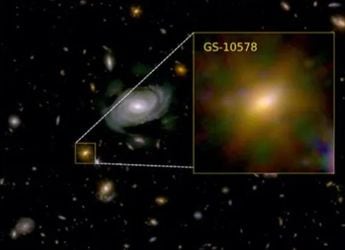- Home
- Science
- Science News
- NASA Video Shows Comet Borisov Visiting From Outside Our Solar System
NASA Video Shows Comet Borisov Visiting From Outside Our Solar System
Comet Borisov was photographed at a distance of 260 million miles (about 41.84 crore km) from Earth.

Photo Credit: NASA, ESA and J. DePasquale (STScI)
An image of Comet Borisov captured by the Hubble telescope on October 12, 2019
NASA's Hubble telescope has captured the interstellar visitor Comet Borisov to our solar system and shared its movement as a runaway point of light in a time-lapse video. The agency said that it “was a rocky visit”. Discovered by amateur astronomer Gennady Borisov in 2019, it is the first confirmed comet to enter our solar system from outside our Sun's influence. Comet Borisov is the only second interstellar object to ever enter our solar system: the first such visitor was an object officially named "Oumuamua". It came within 24 million miles of the Sun before moving out.
However, the more interesting thing about these interstellar visits is that both these objects are very different from each other, throwing a puzzle at scientists to solve. While both appear to be rocky, Borisov is really active, more like a normal comet. It is also relatively small, about the length of nine football fields (0.98 km). Specifically, NASA said, Borisov has a higher concentration of carbon monoxide, suggesting it may have originated around the most common type of star in the Milky Way: a red dwarf.
Comets within the solar system are snowballs of ice, dust and frozen gas, and they orbit the Sun. In their frozen state, they are the size of a small town. When they come closer to the Sun while orbiting it, they heat up and release dust and gases into a giant tail that can extend for millions of kilometres.
Hubble photographed the comet at a distance of 260 million miles (about 41.84 crore km) from Earth. Borisov made its closest approach to the Sun in December 2019, around the time it was first noticed, at twice the distance between Earth and Sun, NASA said previously.
Comets hold a great deal of information about a planetary system's ancient past. So, astronomers are always on the lookout for these objects and gain insights. NASA says comets from our solar neighbourhood reveal the history of materials, including water, that made Earth the planet we know today, as well as our other planetary neighbours.
“On the other hand, an interstellar comet like Borisov is a chemical ambassador from an entirely different star system—containing a treasure trove of clues to worlds too far to reach with modern technology,” the agency added.
Catch the latest from the Consumer Electronics Show on Gadgets 360, at our CES 2026 hub.
Related Stories
- Samsung Galaxy Unpacked 2025
- ChatGPT
- Redmi Note 14 Pro+
- iPhone 16
- Apple Vision Pro
- Oneplus 12
- OnePlus Nord CE 3 Lite 5G
- iPhone 13
- Xiaomi 14 Pro
- Oppo Find N3
- Tecno Spark Go (2023)
- Realme V30
- Best Phones Under 25000
- Samsung Galaxy S24 Series
- Cryptocurrency
- iQoo 12
- Samsung Galaxy S24 Ultra
- Giottus
- Samsung Galaxy Z Flip 5
- Apple 'Scary Fast'
- Housefull 5
- GoPro Hero 12 Black Review
- Invincible Season 2
- JioGlass
- HD Ready TV
- Laptop Under 50000
- Smartwatch Under 10000
- Latest Mobile Phones
- Compare Phones
- Samsung Galaxy A07 5G
- Vivo Y500i
- OnePlus Turbo 6V
- OnePlus Turbo 6
- Itel Zeno 20 Max
- OPPO Reno 15 Pro Mini 5G
- Poco M8 Pro 5G
- Motorola Signature
- Lenovo Yoga Slim 7x (2025)
- Lenovo Yoga Slim 7a
- Realme Pad 3
- OPPO Pad Air 5
- Garmin Quatix 8 Pro
- NoiseFit Pro 6R
- Haier H5E Series
- Acerpure Nitro Z Series 100-inch QLED TV
- Asus ROG Ally
- Nintendo Switch Lite
- Haier 1.6 Ton 5 Star Inverter Split AC (HSU19G-MZAID5BN-INV)
- Haier 1.6 Ton 5 Star Inverter Split AC (HSU19G-MZAIM5BN-INV)

















